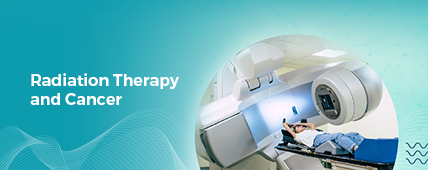
To understand how radiation therapy is helpful in advanced cancers we need to first know the complete elements of radiation therapy, which shall help us understand how Art of Healing Cancer brings all these elements together for either curative or palliative care.

What is Radiation Therapy in Treatment of Cancer?
Radiation therapy is a common cancer treatment that uses high-energy beams to kill cancer cells or stop their growth. Radiation therapy can be used alone or in combination with other cancer treatments, such as surgery, chemotherapy, and immunotherapy.
There are two types of radiation therapy: external beam radiation therapy and internal beam radiation therapy.
- External beam radiation therapy uses a machine outside the body to direct the energy beams at the cancer.
- Internal beam radiation therapy places radioactive material inside the body near the cancer cells.
Radiation therapy can be used to treat many different types of cancer, including brain tumors, breast cancer, lung cancer, prostate cancer, and more.
What is External Beam Radiation

What is Internal Beam Radiation?

Dosing in Radiation Therapy
The amount of radiation delivered to the patient is called the dose. The dose is measured in units of Gray (Gy). A Gray is a unit of energy absorbed by matter. One Gray is equivalent to 100 rads. Doses are typically given in fractions of a Gray, such as 0.5 Gy or 1 Gy.
The total dose of radiation administered to a patient depends on several factors, including the type and stage of cancer being treated, the specific goals of therapy, and the patient’s overall health. Doses are usually given in daily fractions over the course of several weeks.
Radiation doses are carefully calculated to deliver the maximum possible amount of radiation to the tumor while sparing healthy tissue. The dose is typically broken up into smaller “fractions” that are administered over the course of several weeks. This allows the healthy cells to recover from the effects of radiation between treatments.
The total dose of radiation delivered to a patient during radiation therapy can range from 30 Gy to 60 Gy. The most common side effects of radiation therapy include fatigue, skin reactions, and hair loss. More severe side effects may occur with higher doses of radiation.


Radiation in Palliative Care
Radiation therapy is a common treatment for cancer, but it can also be used to relieve pain and other symptoms in patients with terminal illnesses. Radiation can be administered externally, from a machine outside the body, or internally, through implants or injections.
There are many benefits to using radiation in palliative care, including the fact that it is non-invasive, has few side effects, and is often effective in relieving pain and other symptoms. Radiation can also be used to shrink tumors, which can help relieve pressure on vital organs and improve quality of life.
Low Dose Radiation Therapy with Immunotherapy
Low dose radiation therapy (LDRT) is a type of cancer treatment that uses very low doses of ionizing radiation to kill cancer cells. It is sometimes used as an alternative to standard radiation therapy, which uses higher doses of radiation.
LDRT works by damaging the DNA of cancer cells. This damage prevents the cells from growing and dividing, which eventually leads to their death. LDRT can also help the immune system kill cancer cells by releasing antigens, which are substances that stimulate an immune response.
There are a number of potential benefits to using LDRT, including:
- Reduced side effects: Because LDRT uses lower doses of radiation, it is associated with fewer side effects than standard radiation therapy.
- Increased effectiveness: LDRT may be more effective at killing cancer cells than standard radiation therapy, due to the release of antigens.
- Shorter treatment duration: LDRT is typically given in shorter courses than standard radiation therapy, which may be easier for some patients to tolerate.
